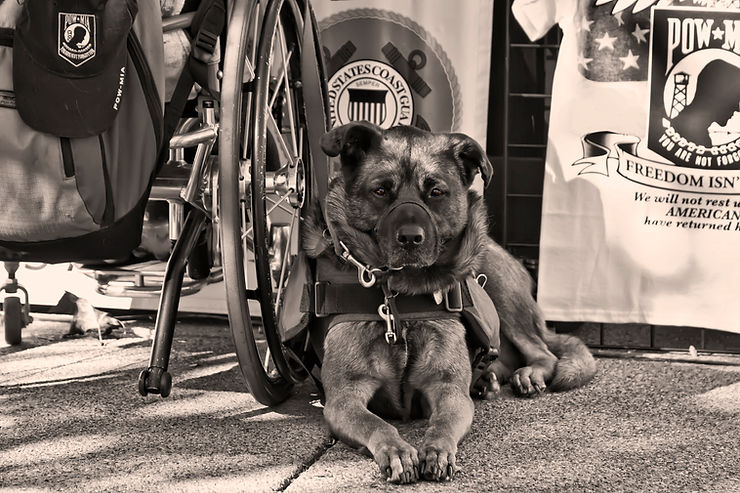
It’s a common occurrence. Someone rolls into a restaurant with a well behaved and vigorously trained service animal, and the hostess looks down with a smile and says, “I have to ask, is this a service animal?” “Yes” replies the hungry patron who just drove 2 hours to meet their friends here. “Ok, let me show you to your table.” The guest rolls to their seat, with the dog heeling obediently by their wheelchair.
Moments later, the manager approaches, “May I see your dog’s papers?” Suddenly, what was supposed to be an enjoyable evening quickly evolves into an embarrassing and uncomfortable scene. While this is frustrating to those who need service animals for legitimate disabilities, the unfortunate proliferation of fake service animals is also frustrating to business owners.
So, what can you as a business owner do to prevent the misuse of your premises, while also not causing undue stress upon those with disabilities?
1. KNOW THE SERVICE DOG LAWS
See below for the most common questions asked. (The full version is available on ada.gov where you can print and share with your staff.)
- What are the laws that apply to my business?
Under the Americans with Disabilities Act (ADA), privately owned businesses that serve the public, such as restaurants, are prohibited from discriminating against individuals with disabilities. The ADA requires these businesses to allow people with disabilities to bring their service animals onto business premises in whatever areas customers are generally allowed.

- What is a service animal?
The ADA defines a service animal as one individually trained to assist an individual with a disability. If they meet this definition, animals are considered service animals under the ADA, regardless of whether they have been licensed or certified by a state or local government.
Service animals perform some of the functions and tasks that the individual with a disability cannot perform for him or herself. Some examples include:
– Alerting person with hearing impairments to sounds.
– Pulling wheelchairs or carrying and picking up things for persons with mobility impairments.
– Assisting persons with mobility impairments with balance.
**The task(s) performed by the dog must be directly related to the person’s disability.
- Are emotional support, therapy, comfort, or companion animals considered service animals under the ADA?
No. These terms are used to describe animals that provide comfort just by being with a person. Because they have not been trained to perform a specific job or task, they do not qualify as service animals under the ADA. However, some state and local governments have laws that allow people to take emotional support animals into public places. You should check with your state and local government agencies to find out about these laws.

- How can I tell if an animal is really a service animal and not just a pet?
Some, but not all, service animals wear special collars and harnesses. Some, but not all, are licensed or certified and have identification papers. In situations where it is not obvious that the dog is a service animal, your staff may only ask two specific questions:
1. Is the dog a service animal required because of a disability?
2. What work or task has the dog been trained to perform?
Staff are not allowed to request any documentation for the dog, require that the dog demonstrate its task, or inquire about the nature of the person’s disability.
“Although several states have programs to certify service animals, you may not insist on proof of state certification before permitting the service animal to accompany the person with a disability.”
- Can service animals be any breed of dog?
Yes. The ADA does not restrict the type of dog breeds that can be service animals.
- What if a service animal barks or growls at other people, or otherwise acts out of control?
You may exclude any animal, including a service animal, from your facility when that animal’s behavior poses a direct threat to the health or safety of others. For example, any service animal that displays vicious behavior towards other guests or customers may be excluded.
Although a public accommodation may exclude any service animal that is out of control, it should give the individual with a disability who uses the service animal the option of continuing to enjoy its goods and services without having the service animal on the premises. The ADA provides greater protection for individuals with disabilities, and so it takes priority over the local or state laws or regulations.
- What does under control mean? Do service animals have to be on a leash? Do they have to be quiet and not bark?

The ADA requires that service animals be under the control of the handler at all times. In most instances, the handler will be the individual with a disability or a third party who accompanies the individual with a disability. In the school (K-12) context and similar settings, the school or similar entity may need to provide some assistance to enable a particular student to handle his or her service animal. The service animal must be harnessed, leashed, or tethered while in public places unless these devices interfere with the service animal’s work or the person’s disability prevents the use of these devices. In that case, the person must use voice, signal, or other effective means to maintain control of the animal.
For example, a person who uses a wheelchair may use a long, retractable leash to allow the service animal to pick up or retrieve items. They may not allow the dog to wander away and must maintain control of the dog, even if it is retrieving an item at a distance from them. Or, a returning veteran with PTSD that has great difficulty entering unfamiliar spaces may have a dog that is trained to enter a space, check to see that there are no threats, and come back to signal that it is safe to enter.
The dog must be off leash to do its job, but may be leashed at other times. Under control also means that a service animal should not be allowed to bark repeatedly in a lecture hall, theater, library, or other quiet place. However, if a dog barks just once, or barks because someone has provoked it, this would not mean that the dog is out of control.
- What can my staff do when a service animal is disruptive?
If a service animal is out of control and the handler does not take effective action to control it, staff may request that the animal be removed from the premises.

- Don’t hesitate to enforce the law
If a person is disruptive and their dog does not meet basic good canine behavior that a service dog would be trained to do, tell the owner to leave. Fake service dogs hurt everyone, and create an environment of distrust while endangering real service animals and the rights of those who truly need them. Learn more about the difference between a legitimate service animal and a fake one here: Casey’s Story. Remember, not all service dogs have to go through private trainer or organization training to be legitimate. Owners can self-train their dogs successfully without a wait or need to raise funds. It is about self-empowerment and not legislating those with disabilities to have to meet more stringent regulations.
2. TRAIN YOUR STAFF ON THE LAW
Have this information as part of your management and employee training. Basic disability etiquette is good to have as well, and this can be combined into one program delivered through video, a training manual, or training session with a team member who has been taught how to conduct this training.
3. GET FEEDBACK
Ask a local disability organization to review your facilities, or ask patrons who come in “is there anything that we can do to make the facility more accessible to you; please let me know. Your input is valued.”
4. HIRE A CONSULTANT. It’s good business to make sure your facilities are friendly to customers with disabilities. Maybe your building code enforcement did a poor job enforcing the codes, or your designer didn’t think about universal design for all, but you can easily take the lead and determine what may prevent guests with mobility disabilities from having an equally pleasant experience at your restaurant.
Consultants can review your plans, do an on-site audit, and quickly assess what can be done affordably (or for no cost at all). There are simple things, such as a high chair blocking the door for a wheelchair user, or your towel/toilet paper dispenser being too high. There are also more critical issues, such as no grab bars in the bathroom, or toilets that are too low (not meeting the 17:-21” standards of the ADA).
When you do a renovation or design upgrade, always hire those who specialize in, or at least understand, the ADA and inclusive “universal design concepts”. Universal design is simply that, a design that can be used universally by all. For example, high top tables are not consistent with this concept because people with arthritis, bad backs, balance issues, or of course wheelchair users, are forced to be segregated to another area, or not eat there at all.
Learning the law, training your staff, asking for feedback, and creating an inclusive atmosphere is a trend that more restaurants should engage in. Your profits will thank you.

